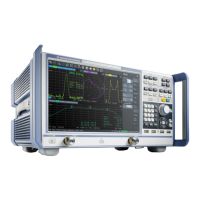Concepts and Features
R&S
®
ZNB/ZNBT
215User Manual 1173.9163.02 ─ 55
Adjust the frequency sweep to the length of the transmission line and the expected dis-
tance to fault:
●
The maximum distance that can be measured is proportional to the number of
sweep points. The larger the number of sweep points, the longer the maximum dis-
tance between the calibrated reference plane and the fault to be located.
●
The maximum distance that can be measured is inversely proportional to the fre-
quency span. The smaller the frequency span, the longer the maximum distance
between the calibrated reference plane and the fault to be located.
However, a smaller frequency span comes at the cost of a coarser distance resolu-
tion.
The R&S ZNB/ZNBT can automatically determine a suitable number of sweep points
for a given maximum distance to fault ("Auto Number of Points"). Moreover it is possi-
ble to define which of the peaks are considered as being due to a fault, and to draw up
and export a list of the detected faults.
A more flexible approach with additional configuration possibilities is available with time
domain option R&S ZNB-K2 / R&S ZNBT-K2 (see Chapter 5.7.2, "Time Domain Analy-
sis", on page 201).
5.7.4 Frequency Conversion Measurements
Option R&S ZNB/ZNBT-K4
With option R&S ZNB/ZNBT-K4, the frequencies of the source ports can be configured
independently. The source and receive frequencies of the ports are always equal. Arbi-
trary port settings represent a major extension to the analyzer's measurement function-
ality; in particular they allow you to measure frequency-converting DUTs.
The following figure shows a transmission measurement on a mixer.
Optional Extensions and Accessories

